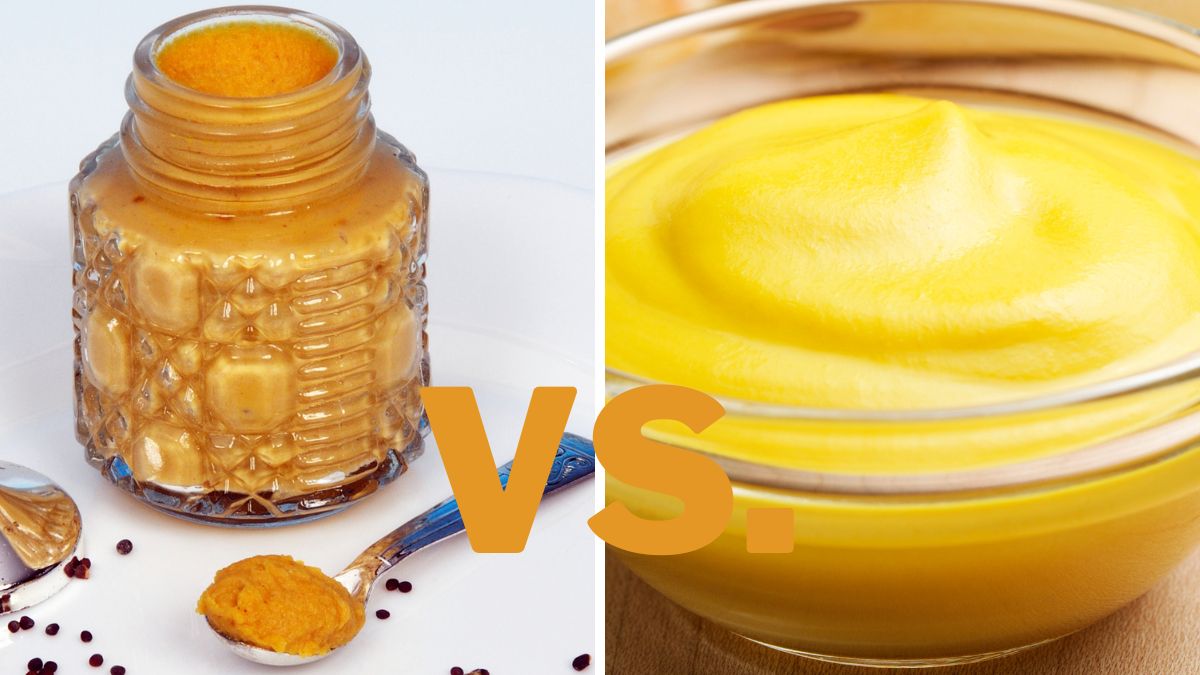English Mustard vs. Yellow Mustard: Differences & Uses

Have you ever wondered about the difference between English mustard and yellow mustard? As someone who loves everything spicy and tangy, mustard is one of my favorite condiments. I used to think that English mustard and yellow mustard were one and the same. However, I was obviously wrong. The two mustards are pretty different in ingredients, flavor, color, and ideal pairings. So, what are their differences exactly?
English mustard is made from brown and yellow mustard seeds, while yellow mustard is made from white seeds and also features other spices. Yellow mustard has a milder taste and a lighter and brighter yellow shade.
My taste buds recently learned about the distinction between these mustards, and I have to say, my sandwiches and pretzels will never be the same. If you’re a fellow mustard lover or just curious to learn more about the difference between English mustard vs. yellow mustard, read on. This tangy topic is worth delving into.
Differences in Ingredients
English mustard, also known as hot mustard, is made from ground mustard seeds, usually a mix of brown and yellow mustard seeds. It has a spicy, tangy kick from turmeric and vinegar that is often used in its preparation. English mustard tends to be coarsely ground, giving it a grainy, spicy texture. It’s usually pale yellow in color.
Yellow mustard, on the other hand, is made from ground white mustard seeds. It also contains other spices, like garlic powder, with a milder, tangier flavor. Yellow mustard is also usually dyed bright yellow with turmeric. The seeds are more finely ground, giving yellow mustard a smoother, creamier texture.
Here you can see what exactly goes into yellow mustard and how to make it yourself at home.
Differences in Taste and Appearance
Regarding flavor and heat, English mustard and yellow mustard are worlds apart. English mustard packs a punch of heat and tang that yellow mustard simply can’t match.
English mustard gets its kick from ground mustard seeds and turmeric. The seeds provide a spicy wasabi-like heat, while the turmeric gives it a bright yellow color and earthy, bitter notes. The result is a sinus-clearing burst of flavor that lingers on your tongue.
Yellow mustard, on the other hand, uses milder white mustard seeds. Vinegar and spices are added, diluting the heat and producing a sweeter, tangier taste. The flavor dissipates quickly, leaving little aftertaste.
While English mustard adds heat and depth of flavor to dishes like sausages, cheeses, and sandwiches, yellow mustard complements lighter foods like hot dogs, pretzels, and salads. For most Americans, yellow mustard hits the spot, but English mustard can’t be beaten for those craving bolder, spicier flavors, myself among them.
At first glance, English mustard and yellow mustard look pretty similar. They’re both made from ground mustard seeds and have a yellowish tint. However, a few key differences in their appearance can help tell them apart.
For starters, English mustard tends to be darker in color, ranging from bright yellow to deep gold. Yellow mustard, on the other hand, has a lighter, brighter yellow shade like that of a daffodil or sunflower. English mustard also usually has visible seeds or seed fragments, giving it a speckled look. Yellow mustard has a smoother, creamier texture since the seeds are more finely ground.
Differences in Uses

English mustard is my go-to for hearty meat dishes like corned beef, pastrami, or sausage. Its spicy, tangy kick helps cut through the richness and adds great flavor. Yellow mustard can seem a bit mild and get lost. When making rubs, marinades, or sauces for beef, pork, or lamb, English mustard is usually my first choice.
On the other hand, for sandwiches, I typically prefer yellow mustard. Its mellower, sweeter flavor pairs better with most sandwich fillings, in my opinion. Whether it’s ham and cheese, roast beef, or hot dog, yellow mustard complements the ingredients without overpowering them. English mustard can be a bit abrasive on a sandwich. I used yellow mustard for Kneaders sauce, so give it a try!
For spreading on pretzels or using as a dip for fries, chips, or chicken fingers, yellow mustard also gets my vote. Its milder taste and creamier consistency make it ideal for dipping and spreading. English mustard is better suited as a condiment or ingredient rather than a dip or spread.
In baking or cooking, either mustard can work depending on the recipe. Yellow mustard may provide more moisture and a mellower flavor in some baked goods like pretzels, whereas English mustard can add more zing to glazes, dressings, and marinades. However, its spiciness means you only need a little, so use sparingly.
At the end of the day, both mustards have a place in my kitchen. By choosing one mustard over the other based on how I plan to use it, I can maximize the flavor and enjoy the best of both worlds.
Are English Mustard and Yellow Mustard Interchangeable?
While English mustard and yellow mustard come from the same family of plants, their distinct ingredients, flavors, and uses mean they are not directly interchangeable.
If substituting one for the other in a recipe, you’ll need to adjust amounts and possibly other seasonings to account for their spiciness and overall taste differences. For me, there’s a time and place for both mustards — I just need to choose wisely based on what I’m making and my personal tastes!
So, in summary, although English mustard and yellow mustard are both derived from mustard seeds, they have distinct properties that make each better suited for particular culinary uses. With some experimenting, you can discover which of these spicy condiments you enjoy and in what types of dishes.
And, of course, have fun doing it! Also, I would love to read about your adventures! Tell me everything in the comments below!
